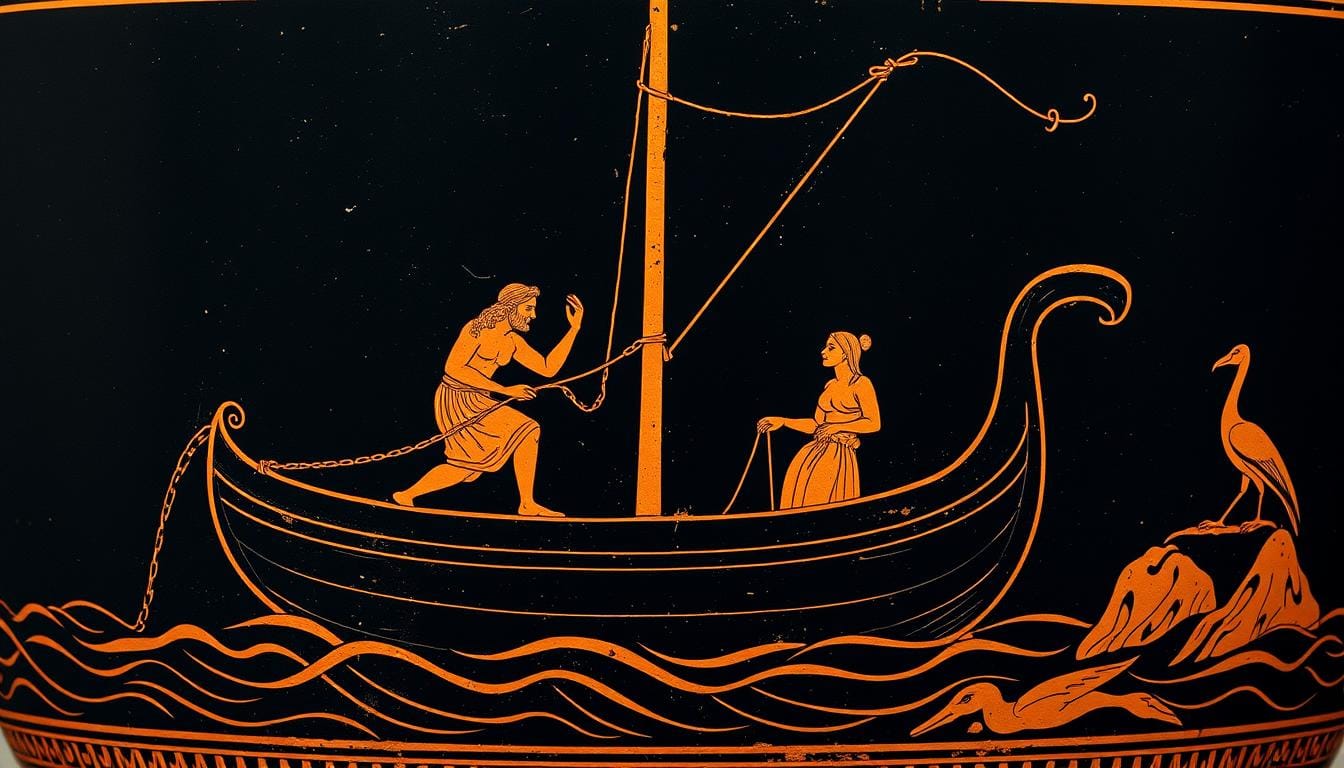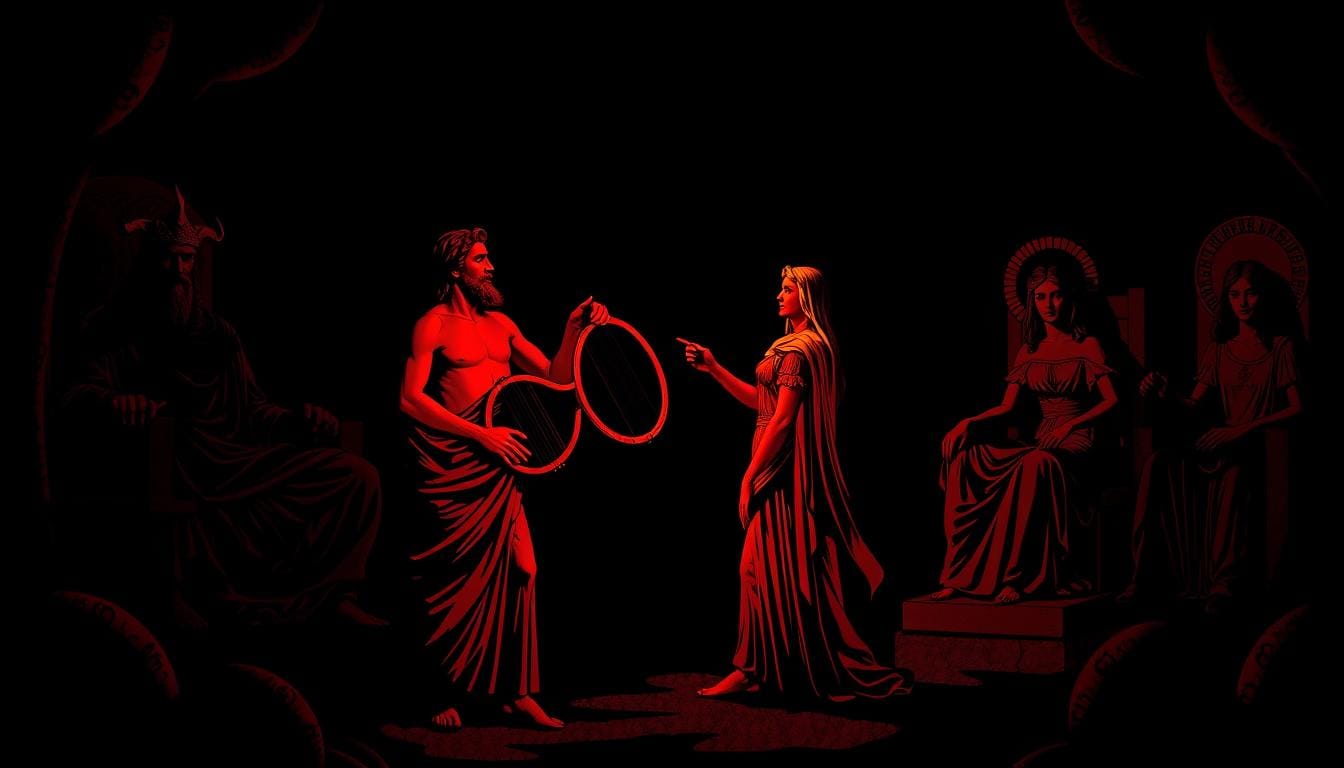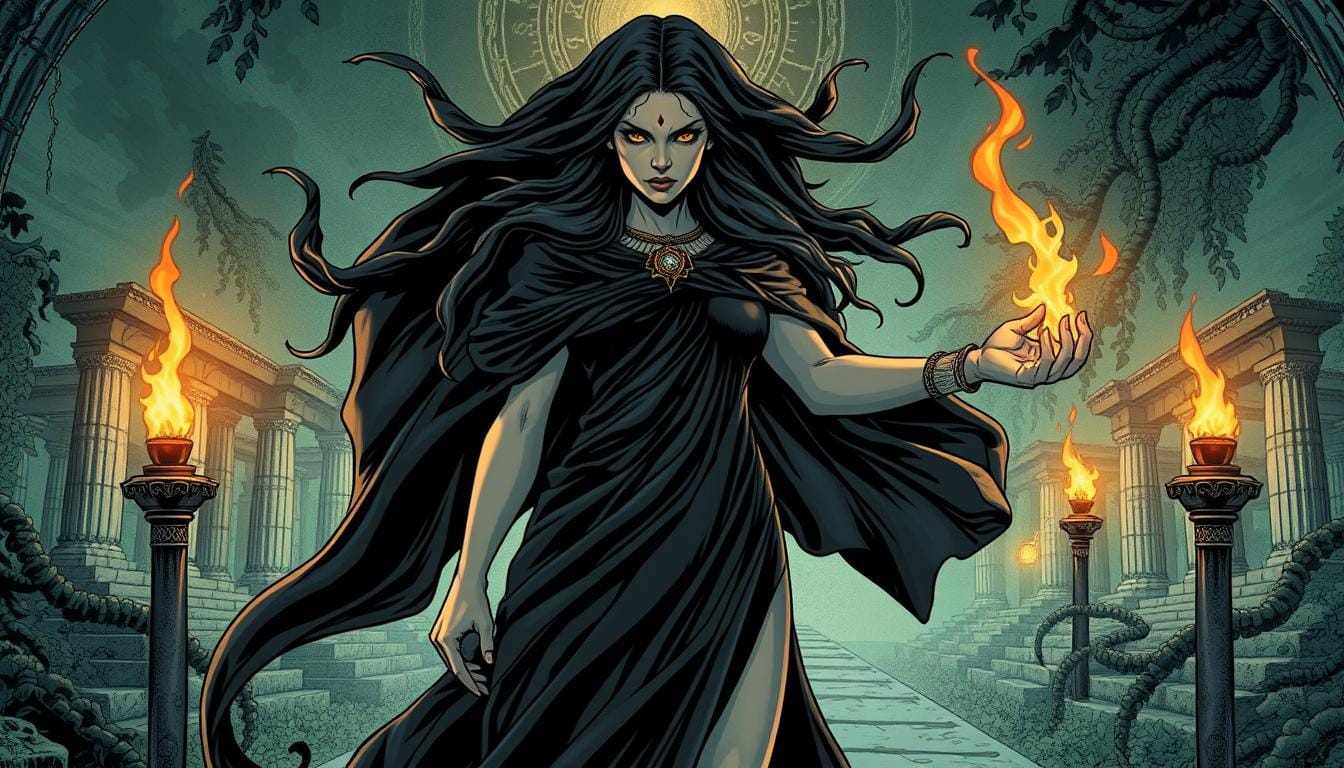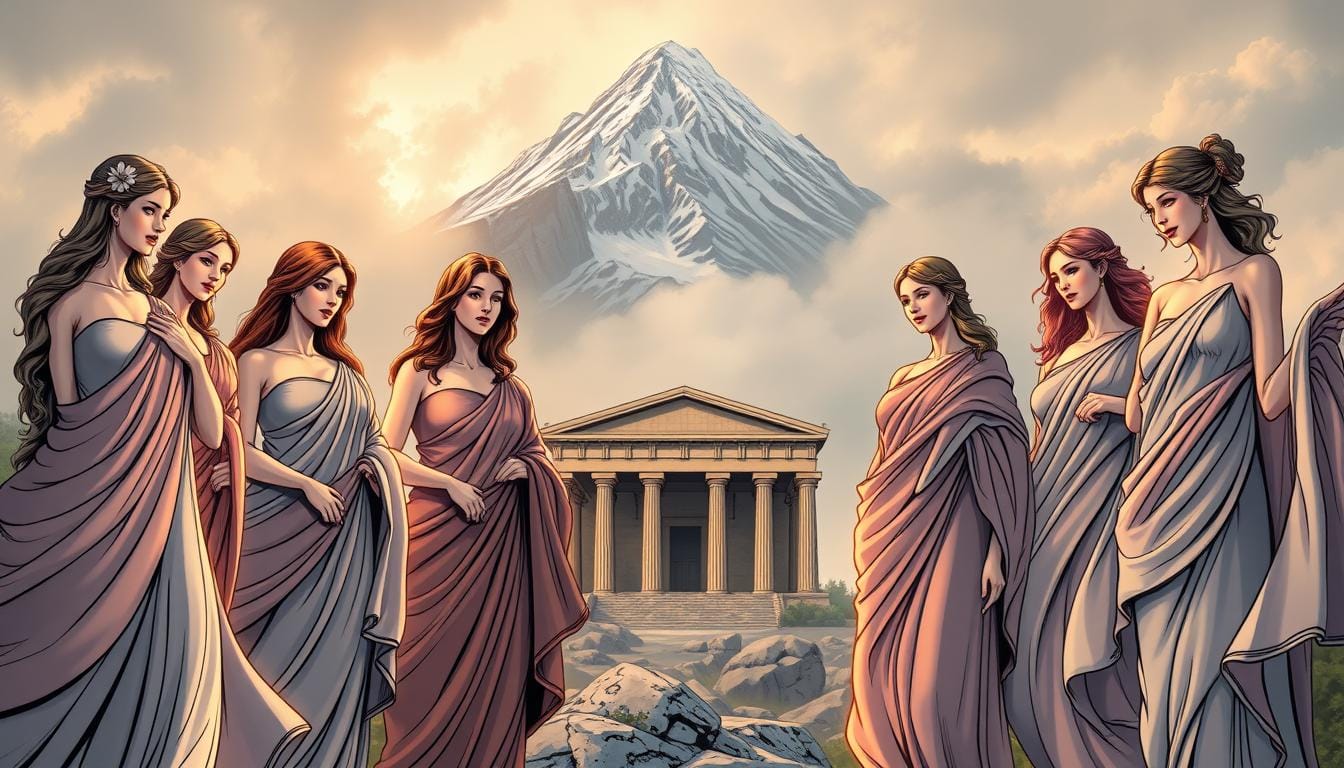In the rich tapestry of Greek mythology, few figures embody such fascinating contradictions as Hermes Greek God. Swift-footed and silver-tongued, Hermes navigated between divine and mortal realms with unmatched ease. As the messenger of the gods, he carried Zeus’s commands across the cosmos, yet his identity extended far beyond this role. Hermes embodied the ultimate boundary-crosser – a divine messenger, cunning trickster, guide of souls, and patron of travelers, merchants, and thieves alike. His dual nature made him both respected and feared, trusted and questioned, revealing the complex relationship ancient Greeks had with this multifaceted deity.
The Latin Name for Hermes
When the Greeks spoke of Hermes, the Romans saw him through a slightly different lens. In Latin, Hermes is known as “Mercurius”—or Mercury to modern ears. Just as Hermes zipped from Olympus to the underworld with winged sandals, Mercury became the fleet-footed messenger among Roman gods. The name change didn’t alter his essential traits: quick-witted, cunning, and always caught between worlds.
Was There More Than One Hermes in Greek Myth?
The enigmatic nature of Hermes led to some intriguing speculation among ancient thinkers. Because Hermes wore so many hats—messenger, trickster, shepherd of souls, and patron of so many crafts and crossroads—a few scholars in antiquity wondered if there might, in fact, be several deities sharing the same name. Figures like Cicero, the Roman orator, wrote about multiple “Hermeses,” sometimes distinguishing as many as five. Others, such as the commentator Servius, divided his roles among four separate gods.
Of course, many of these interpretations blended Hermes with similar foreign deities or local gods with overlapping duties. Still, this confusion only highlights just how fluid and versatile Hermes was: a single god, yet seemingly everywhere at once, shape-shifting to meet the needs of mortals and immortals alike.
What’s in a Name? The Many Faces of Hermes
Before we dive deeper into Hermes’ adventures, let’s clarify his name as it appears across languages and ages—a detail as multifaceted as the god himself.
- Greek: Ἑρμῆς
- Transliteration: Hermês
- Latin Spelling: Hermes
Each version carries its own history, echoing through ancient texts from the temples of Arcadia to the scrolls of Roman scholars. Whether you’re reading the Iliad in Greek or scrolling through Latin treatises, Hermes’ name endures—just as adaptable as the god it represents.
Origins of Hermes: Divine Birth and Early Mischief
Mount Cyllene in Arcadia, Greece – birthplace of Hermes
Born in a secluded cave on Mount Cyllene in Arcadia, Hermes was the son of Zeus, king of the gods, and the nymph Maia, one of the seven Pleiades. According to the Homeric Hymn to Hermes, his divine nature manifested immediately after birth:
“Born with the dawning, at mid-day he played on the lyre, and in the evening he stole the cattle of far-shooting Apollo on the fourth day of the month.”
Homeric Hymn to Hermes
This remarkable precocity set the tone for Hermes’ character. Unlike other Olympians who grew gradually into their powers, Hermes emerged fully formed in his cunning and abilities. Within hours of his birth, he slipped from his cradle, determined to establish his place among the gods through cleverness rather than force.
His first act – stealing Apollo’s sacred cattle – demonstrated his core traits. Not only did he steal the cattle, but he cleverly reversed their hoofprints and created the first sandals to hide his tracks. When confronted by an angry Apollo, the infant Hermes charmed his way out of punishment by offering Apollo the lyre he had just invented from a tortoise shell. This early myth established Hermes as both a trickster and a diplomat, capable of resolving conflicts through wit and gifts.
Titles and Epithets of Hermes in Classical Hymns
Hermes was no stranger to grand titles and meaningful epithets in ancient Greek literature—each reflecting a different facet of his elusive, multi-layered persona.
Divine Names and Roles
In the Homeric Hymns and Orphic poetry, Hermes is praised as “the son of Zeus and Maia,” underlining his noble lineage. Known fondly as “Lord of Kyllene” and “Lord of Arcadia rich in flocks,” he’s inseparably tied to the rugged regions of his mythical birth. You’ll often encounter him as the “luck-bringer” (Eriounes), a subtle nod to the unexpected windfalls—or misfortunes—he brought to mortals and gods alike.
Hermes’ role as messenger is etched firmly in his epithets: he’s “Angelos Athanaton” (messenger of the deathless gods), and also “Angelos Makaron,” carrying news and commands with celestial efficiency. His winged feet and cap are more than fancy accessories; they’re symbols of his swift, crucial function as intermediary.
Protector, Guide, and Giver of Grace
Epithets like “Guide” (Diaktoros) and “Giver of Good Things” (Dotor eaon) highlight his benevolent side, often invoked for luck in journeys, trade, and communication. As “Khrysorrapis,” or bearer of the golden rod, he’s pictured with the caduceus—his iconic staff entwined with serpents—marking his dual authority over peace and passage between worlds.
Then there’s “Argeiphontes,” the “Slayer of Argus,” showcasing his cunning ability to outwit even the most vigilant of guardians. And, as the “Chthonian Hermes,” he’s summoned as a guide of souls—psychopompus—ushering the departed safely to the realm of Hades with, one hopes, a gentle hand and minimal trickery.
Whether invoked as “Giver of Grace” or “Friend of Man,” these names remind us that Hermes was not just a god of travelers, but a companion to mortals and immortals alike—a being whose titles were as versatile as the roles he played.
Hermes Greek God embodied numerous roles in ancient Greek religion, serving as a bridge between different worlds and aspects of life. His versatility made him one of the most frequently invoked deities in daily Greek life.
Hermes as Father: The Offspring of the God of Boundaries
Hermes’ legacy in Greek mythology extended into the next generation through his many children—demonstrating that his knack for crossing boundaries was passed along in more ways than one.
Among his most famous offspring is Pan, the wild, goat-legged god of the shepherds, fields, and rustic music. According to myth, Pan was born from Hermes’ union with the nymph Penelopeia (not to be confused with Odysseus’s wife). With his unmistakable horns and lively pipes, Pan inherited both his father’s mischievous spirit and his easy passage between the civilized and untamed worlds.
But Pan was not Hermes’ only child. Hermes had many mortal children as well, often fathering heroes, clever thieves, and heralds—mirroring the variety in his own roles. Some accounts include Autolycus, famed for his thievery and cunning, and Myrtilus, a crafty charioteer whose betrayal sparked a legendary curse.
In these offspring, we see echoes of Hermes’ complexity—a divine heritage that found countless ways to shape both myth and daily life for the Greeks.
The Dual Roles of Hermes in Greek Mythology
Hermes Greek God embodied numerous roles in ancient Greek religion, serving as a bridge between different worlds and aspects of life. His versatility made him one of the most frequently invoked deities in daily Greek life.
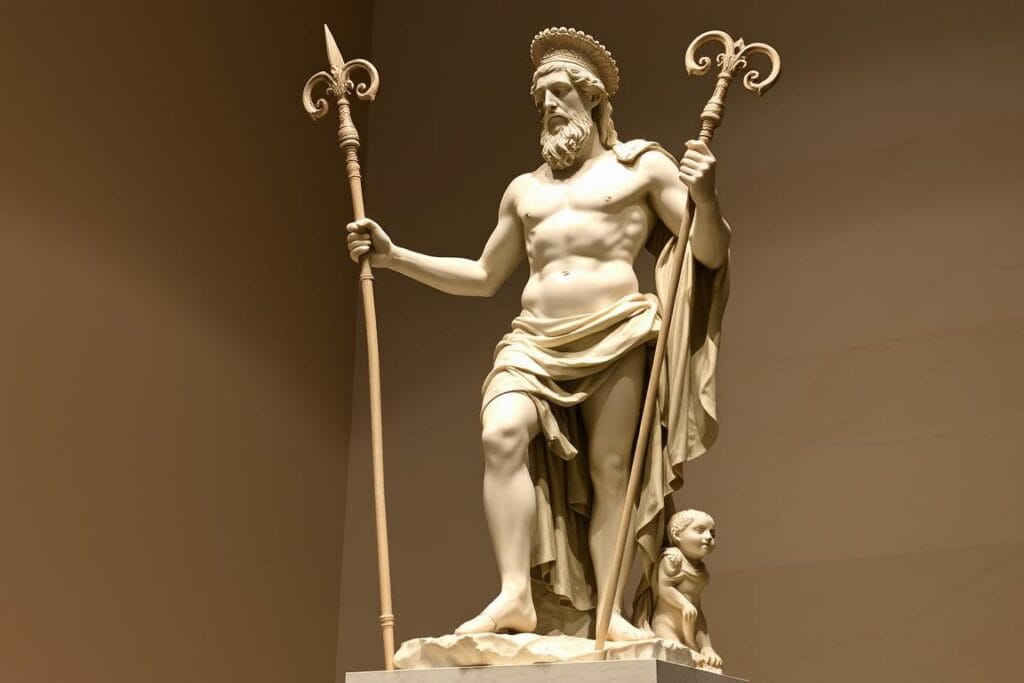
Divine Messenger and Herald
As the official messenger of the gods, Hermes carried divine communications across all realms. His winged sandals (talaria) and winged cap (petasos) enabled him to travel with supernatural speed. The caduceus – his herald’s staff entwined with two serpents – marked his official capacity as Zeus’s representative.
This messenger role extended beyond simple communication. Hermes often served as a diplomatic envoy, negotiating between gods or between gods and mortals. His eloquence and persuasiveness made him the perfect intermediary in delicate situations, such as when he convinced Hades to release Persephone temporarily to her mother Demeter.
Hermes’ Role in Perseus’ Legendary Quest
Hermes also played a crucial role in the saga of Perseus and the Gorgon Medusa. Acting as both guide and benefactor, Hermes provided Perseus with indispensable aid: he bestowed upon him a pair of winged sandals, granting the hero the swiftness to soar through the air, and offered keen advice to help Perseus navigate the perilous challenges ahead. Alongside Athena, Hermes ensured Perseus had the tools and guidance needed to face Medusa, further highlighting Hermes’ knack for assisting mortals at pivotal moments.
Hermes in Major Myths: The Judgement of Paris and the Birth of Athena
Hermes’ influence in Greek mythology extended well beyond his familiar roles as messenger and trickster. He often appeared at key moments during major mythological events, playing pivotal—if sometimes understated—parts that shaped the course of legendary tales.
The Judgement of Paris: When Eris, goddess of discord, sowed chaos among the gods by tossing the golden apple inscribed “to the fairest,” it fell to Hermes to act as an impartial chaperone. Tasked by Zeus, Hermes escorted Hera, Athena, and Aphrodite to the mortal Paris of Troy. His role was both practical and diplomatic: he not only delivered the three goddesses safely but also ensured the fateful beauty contest commenced, indirectly setting the stage for the Trojan War.
The Birth of Athena: Hermes was also present at the dramatic birth of Athena, springing fully armoured from the head of Zeus. Ancient vase paintings often depict Hermes, staff in hand, standing beside Hephaestus or Zeus himself, providing calm assurance amid the chaos. As a steadying intermediary on Olympus, Hermes helped maintain order at this momentous occasion, highlighting his status as the gods’ trusted attendant during crises.
Across numerous myths, whether ferrying messages or supporting in divine births and challenges, Hermes emerges as the ever-resourceful facilitator—always at the crossroads of fate, ready with a steady hand and a knowing smile.
Psychopomp: Guide of Souls
Perhaps Hermes’ most solemn duty was guiding newly deceased souls to the underworld. As a psychopomp (soul guide), he escorted the dead across the boundary between life and death. This chthonic aspect of Hermes connected him to the mysteries of mortality and the afterlife.
“Cyllenian Hermes called forth the souls of the suitors… and led them along, while they followed gibbering.”
Homer’s Odyssey, Book 24
Patron of Travelers, Merchants, and Thieves
Hermes extended his protection to those who crossed boundaries in the mortal realm. As patron of roads and travelers, he watched over those journeying far from home. Travelers would often pile stones at crossroads as offerings to Hermes for safe passage.
His association with commerce stemmed naturally from his role in facilitating exchange and movement. Merchants prayed to Hermes for profitable ventures and safe transport of goods. Yet this same god also watched over thieves and those who lived by their wits, appreciating cleverness in all its forms.
Hermes in the Orphic Hymns: Divine Functions and Mystical Powers
The Orphic Hymns, a collection of ancient religious poetry, paint an especially vivid portrait of Hermes’ wide-ranging abilities and responsibilities. Far from limiting him to trickster tales and messenger duties, these hymns celebrate Hermes as a god of manifold talents—both celestial and chthonic.
Celestial Messenger and Patron of Speech
Throughout the Orphic Hymns, Hermes appears foremost as the ever-resourceful messenger of Zeus and Maia’s clever son. He is hailed for mastering both language and persuasive speech, bestowing eloquence and memory on those who honor him. His role as the “prophet of discourse” makes him the divine patron of orators, poets, and anyone seeking skilled communication.
Guide of Souls and Chthonic Keeper
The hymns further highlight Hermes’ crucial responsibility as a psychopomp. In this underworld aspect, he is stationed by the river Kokytos and serves as the guide who leads departed souls to Hades’ realm—a journey from which no mortal returns. Entrusted by Persephone herself, Hermes wields the wand that grants peaceful sleep or awakens the weary, acting as both a liberator from earthly cares and a gentle usher to the afterlife.
Supporter of Human Endeavor and Fortune
Hermes’ influence extends into human affairs, offering protection and assistance in times of need. He is invoked as a champion in athletic contests, a source of good fortune and gain, and a benefactor who brings success in both everyday endeavors and sacred rites. The hymns describe him as a deity who loosens worries, fosters peace, and brings profitable outcomes to devoted followers.
In essence, the Orphic Hymns recognize Hermes as a multi-dimensional power: a swift-footed messenger, eloquent teacher, steadfast guide of souls, and ever-watchful supporter of mortals as they navigate the unpredictable crossroads of life.
God of Luck, Wealth, and Games of Chance
Hermes’ reputation extended beyond messages and mischief—he was also deeply tied to fortune and prosperity. The Greeks considered him a bestower of unexpected wealth, especially gains that arrived suddenly through trade or clever dealings. Merchants seeking quick profits or safe returns would invoke Hermes, hoping his favor would tip luck in their direction.
But Hermes’ association with luck didn’t stop at commerce. He presided over games of chance, especially dice, which were wildly popular in ancient Greece. Players would dedicate the first roll to Hermes, often tossing an olive leaf onto the dice for good fortune—a ritual acknowledging the god’s influence over both the whims of fate and the outcome of risky ventures. In this role, Hermes embodied both the thrill of chance and the hope for luck’s generous hand.
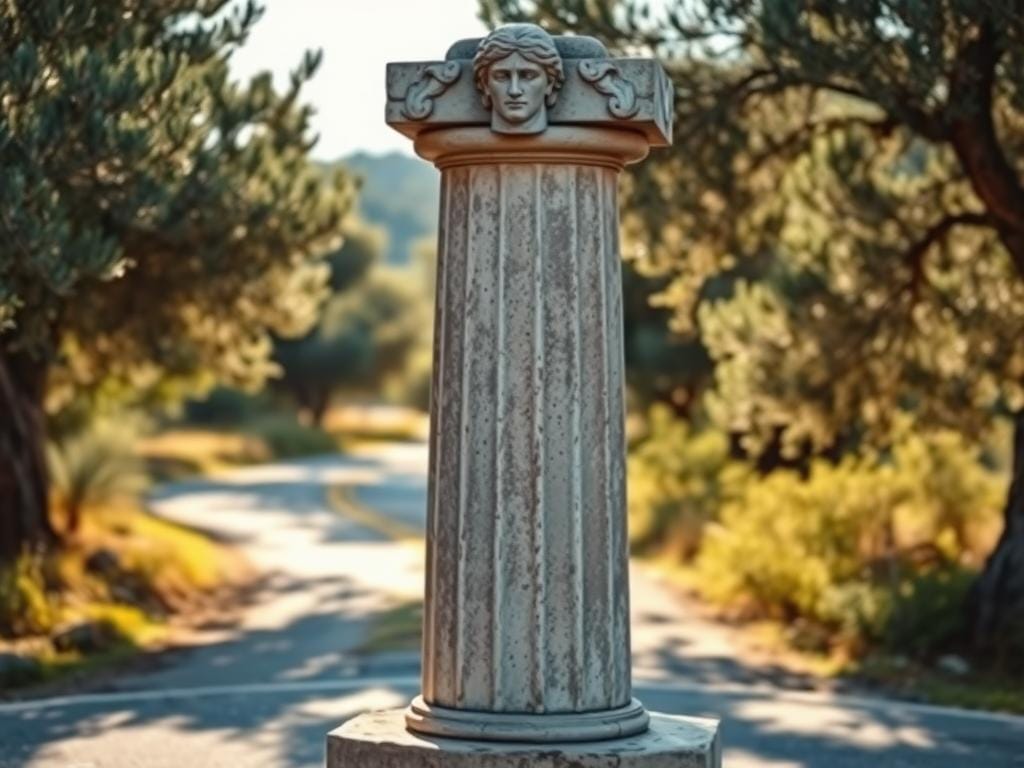
A herma pillar marking a crossroads – a common sight in ancient Greece
Key Myths of Hermes: Trickster Tales and Divine Missions
The Cattle Theft and Invention of the Lyre
Hermes’ most famous myth occurred on the very day of his birth. The newborn god snuck away from his cradle, traveled to Pieria, and stole fifty cattle belonging to his brother Apollo. To conceal his theft, Hermes created the first sandals and made the cattle walk backward, confusing anyone following their tracks. He then sacrificed two cows and returned to his cradle, feigning innocence.
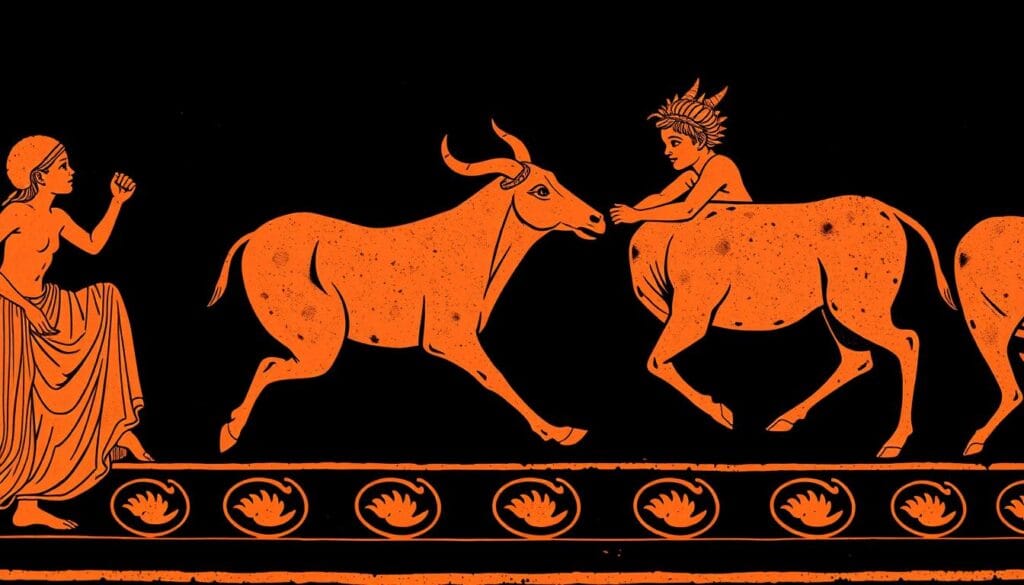
When Apollo discovered the theft and confronted him, Hermes charmed his way out of trouble by presenting Apollo with the lyre he had crafted from a tortoise shell and cow gut. Apollo was so enchanted by the instrument that he forgave Hermes and exchanged the remaining cattle for it. This myth established Hermes as both a trickster and a brilliant inventor, capable of transforming potential conflict into mutual benefit.
The Fate of Battos: Hermes and the Consequences of Betrayal
Hermes’ cunning was not reserved solely for the gods; mortals, too, could find themselves unwitting pawns in his schemes. In one lesser-known episode following the cattle theft, Hermes crossed paths with Battos, a herdsman who witnessed the young god hiding Apollo’s stolen cattle. Hermes, ever wary, tried to bribe Battos into silence—but when Battos betrayed him by revealing the theft, Hermes acted swiftly.
Not one to tolerate informants, Hermes transformed Battos into stone as punishment for his indiscretion. This myth underscores Hermes’ appreciation for cunning loyalty—and the swift consequences faced by those who disrupt his clever plots.
Hermes and the Rescue of Io
When Zeus transformed his lover Io into a cow to protect her from Hera’s jealousy, Hera set the hundred-eyed giant Argus to guard her. Zeus sent Hermes to rescue Io. Using his skills as a storyteller and musician, Hermes lulled all of Argus’s eyes to sleep with boring tales and soft music from his reed pipes. Once Argus was asleep, Hermes slew him and freed Io, earning the epithet “Argeiphontes” (slayer of Argus).
Hermes and the Princess Khione
Hermes’ adventures sometimes led him into stories of romance and intrigue. One notable myth tells of his encounter with Khione (also spelled Chione), a princess celebrated for her beauty. On a single night, Khione attracted not only Hermes but also Apollo, each visiting her in turn. With his trademark swiftness, Hermes approached Khione silently, ensuring she would not be startled by his presence. Their union resulted in the birth of Autolycus, who inherited Hermes’ cleverness and skill in thievery, later becoming a renowned master of stealth and trickery in his own right.
This episode highlights Hermes’ role as a father to mortals and heroes, as well as his penchant for crossing boundaries—this time, between the divine and the human.
Hermes in the Odyssey
In Homer’s Odyssey, Hermes appears as a crucial ally to Odysseus. When the hero was trapped on Calypso’s island, Zeus sent Hermes to command the nymph to release him. Later, when Odysseus encountered the sorceress Circe, Hermes provided him with the magical herb moly to protect him from her spells.
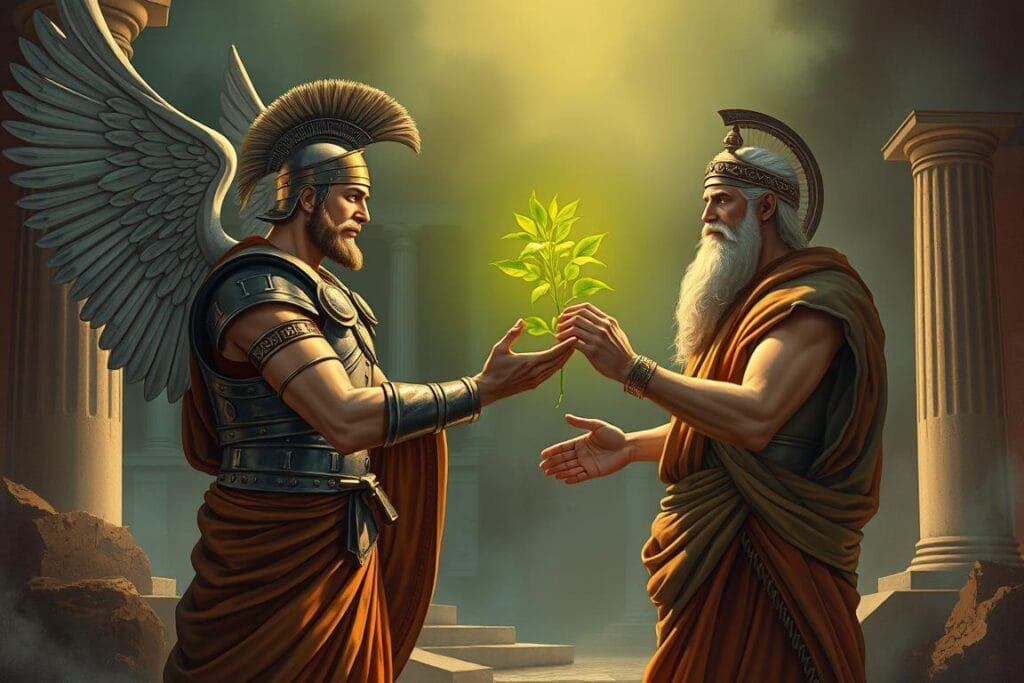
This intervention showcased Hermes’ role as a protector of travelers and his function as a bridge between the divine and mortal worlds. By providing Odysseus with divine knowledge and tools, Hermes exemplified his role as a mediator who helps mortals navigate supernatural challenges.
Symbols and Attributes of Hermes
The iconography associated with Hermes Greek God evolved over centuries, with each symbol reflecting an aspect of his complex divine nature.

The caduceus – Hermes’ herald staff and symbol of his authority
Primary Symbols of Hermes
- Caduceus (Kerykeion) – A staff entwined with two serpents and topped with wings, symbolizing his role as herald and messenger. Originally a simple herald’s staff, it evolved to include serpents after Hermes used it to separate two fighting snakes.
- Winged Sandals (Talaria) – These magical sandals allowed Hermes to travel with divine speed between worlds, representing his mobility and role as messenger.
- Petasos – A broad-brimmed traveler’s hat, often depicted with wings, that protected Hermes during his journeys.
- Tortoise/Lyre – Representing his invention of the lyre and his association with music and arts.
- Herma – Stone pillars topped with Hermes’ bust and featuring a phallus, placed at crossroads, boundaries, and doorways as protective markers.
Sacred Plants of Hermes
Hermes was not only tied to the bustling world of travelers and clever merchants—he also had botanical associations that appeared throughout Greek myth and art. Two plants held particular significance for Hermes:
- Crocus: The crocus flower, with its bright, delicate petals, was linked to Hermes, representing youth, agility, and new beginnings—qualities the god embodied in his many roles.
- Strawberry Tree (Arbutus): The evergreen strawberry tree’s fruit and foliage were also considered sacred to Hermes. In ancient Greek lore, this plant symbolized vitality and endurance, echoing Hermes’ untiring energy as a messenger and protector.
These sacred plants often accompanied depictions of Hermes and were sometimes featured in offerings to the god, further reflecting his presence in both the natural and divine realms.
Hermes as Patron of Shepherds and Fertility
Hermes’ unique relationship with shepherds traces back to his roots as a god of the fertile earth and pastoral life, especially in the ancient Arcadian tradition. Beyond guiding travelers and merchants, Hermes was believed to bestow prosperity upon flocks, granting health and prolific offspring to sheep and cattle. This made him an essential figure for those whose livelihood depended on the well-being of their animals.
Shepherds looked to Hermes not just as a guardian but as a bringer of abundance, capable of ensuring lush pastures and plentiful herds. He was sometimes honored alongside rustic deities like Pan and the Nymphs, underscoring his enduring connection to rural life and nature’s cycles. In sacrificial rituals and everyday prayers, shepherds sought Hermes’ blessings to protect their animals and encourage the flourishing of their flocks—an echo of his ancient role as a giver of growth and vitality.
Greek vs. Roman Depictions: Hermes and Mercury Compared
Both the Greeks and Romans revered the swift-footed god of messages, but their artistic lenses colored him in distinctive ways.
In ancient Greek art and literature, Hermes began as a bearded, mature guide—a fitting look for a god trusted with escorting souls and outwitting giants. Over time, especially from the Classical period onward, Greek artists favored a more youthful image: Hermes appears energetic, typically beardless, and exudes agility. Hallmarks like the caduceus, winged sandals, and petasos hat became staple features, emphasizing his roles as a messenger and an inventive trickster. Paintings and sculpture—think of the lively red-figure pottery of Athens—frequently show him mid-motion: delivering messages, presiding over contests, or engaging in mythic mischief like the rescue of Io.
The Romans, on the other hand, adopted Hermes under the name Mercury and gave him a subtle makeover. Mercury is usually portrayed as even more youthful, radiant, and somewhat softer in demeanor than many Greek versions. Roman artists often depicted him with elegantly arranged hair and polished attire, perhaps reflecting the Roman taste for idealized, almost theatrical presentation. The Romans emphasized his aspect as the patron of travelers, merchants, and communication, often adding their own details—such as a slightly flashier set of winged sandals and a cap gleaming with decorative flair.
Aesthetically, where Greek representations balance athleticism with playful intelligence, Roman Mercurys tend toward the allure of polished beauty, often captured in marble or grand mosaics. Practical Greek vase scenes show Hermes active in myth, while Roman statuary and frescoes commonly highlight his divine elegance—sometimes even using gold wings in his hair or vignettes from Roman literature.
Put simply:
- Greek Hermes: Youthful, athletic, quick-witted; often depicted in action and imbued with lively, mischievous energy.
- Roman Mercury: Youthful and strikingly handsome; attire and features are rendered with heightened elegance, and the depiction focuses on his role as a communicator and divine herald in Rome’s bustling society.
Despite these differences, the central motifs remain the same—winged accessories, the iconic caduceus, and the aura of a god who moves effortlessly between worlds. Hermes, whether Greek or Roman, never stands still for long.
Sacred Animals of Hermes
Among the many symbols woven into Hermes’ mythology, several animals stood out as especially sacred to him. The ram, often depicted bearing the god on its back in ancient art, was a prominent emblem of Hermes’ connection to herding and pastoral life. The hare, swift and elusive, also held special significance. Beyond these, Hermes was closely linked with a range of livestock—including cattle, goats, and sheep—reinforcing his role as protector of flocks and shepherds across the Greek countryside.
Hermes in Ancient Art
In early Greek art, Hermes was typically portrayed as a mature, bearded man. By the Classical period (5th-4th centuries BCE), his image transformed into that of an athletic, beardless youth – reflecting his association with gymnasiums and athletic contests. This youthful depiction became the standard representation, emphasizing his agility and eternal vigor.
Sacred Animals and Plants of Hermes in Ancient Art
Hermes’ divine presence extended not only to symbols and attributes but also to certain animals and plants, each with its own place in ancient Greek art.
The ram and the hare were especially significant among Hermes’ sacred animals. Artworks sometimes show Hermes astride a ram, highlighting his ancient role as guardian of flocks and protector of shepherds. Hares, swift and elusive, echoed the god’s agility and wit, making frequent appearances alongside him in vase paintings and reliefs.
Cattle, sheep, and goats—animals associated with pastoral life—often appear in scenes celebrating Hermes’ connection to herding and rustic boundaries.
Equally meaningful are the plants linked to Hermes. The crocus flower, with its vibrant colors, and the strawberry tree are depicted in decorative borders or held delicately in the god’s hands, weaving together the themes of natural abundance and vitality.
Together, these representations celebrated Hermes not just as a messenger and trickster, but as a deity woven into the daily rhythms of countryside life, his presence recognized wherever animals grazed or seasonal flowers bloomed.
Hermes in Vase Paintings and Sculpture: Key Mythological Scenes
The artistry of ancient Greece vividly captured Hermes across a wide spectrum of mythological tales, making him a familiar figure on vase paintings and classical sculptures. If you were to wander through the collections at the Louvre or study the pots lining the cases at the British Museum, you would encounter Hermes donning his signature petasos hat and winged sandals in an impressive variety of narratives.
Some of the most frequent scenes featuring Hermes include:
- The Births of Gods and Heroes: Hermes appears at the birth of Athena, Aphrodite, and Dionysus—often as a witness or helper, standing among Olympian deities.
- The Rescue of Io and Slaying of Argus: Hermes, in his role as the cunning liberator, is shown charming and slaying Argus Panoptes to free Io, demonstrating both his wit and daring.
- The Judgment of Paris: He is often depicted leading Hera, Athena, and Aphrodite to Paris for the fateful decision sparking the Trojan War.
- Guiding Heroes and Souls: As psychopomp, Hermes leads souls to the underworld—sometimes depicted beside Charon or guiding Persephone.
- Adventures with Heracles: Scenes frequently show Hermes assisting Heracles, most notably during the hero’s descent into the underworld to retrieve Cerberus.
- Infancy and Childhood Scenes: The god appears caring for or abducting young heroes and gods, such as baby Dionysus or Heracles.
- Musical and Artistic Moments: Hermes gives Apollo the lyre, or plays the pipes, underscoring his reputation as the god of invention and music.
- Assembly of the Gods: He often appears at grand councils on Olympus, mingling with Zeus, Hera, and the other Olympians.
In sculptural form, Hermes is famously rendered in Praxiteles’ “Hermes with the Infant Dionysus,” as well as a range of marble and bronze statues from the Roman era, where he is known by his Latin name, Mercury. His statues frequently functioned as boundary markers—herms—placed at crossroads and city gates, highlighting his protective role.
Through these artistic portrayals—be it racing across the rim of a krater or standing poised in glimmering marble—Hermes’ versatility and omnipresence in myth are brought vividly to life, demonstrating why he remains one of the most recognizable of the Greek gods.
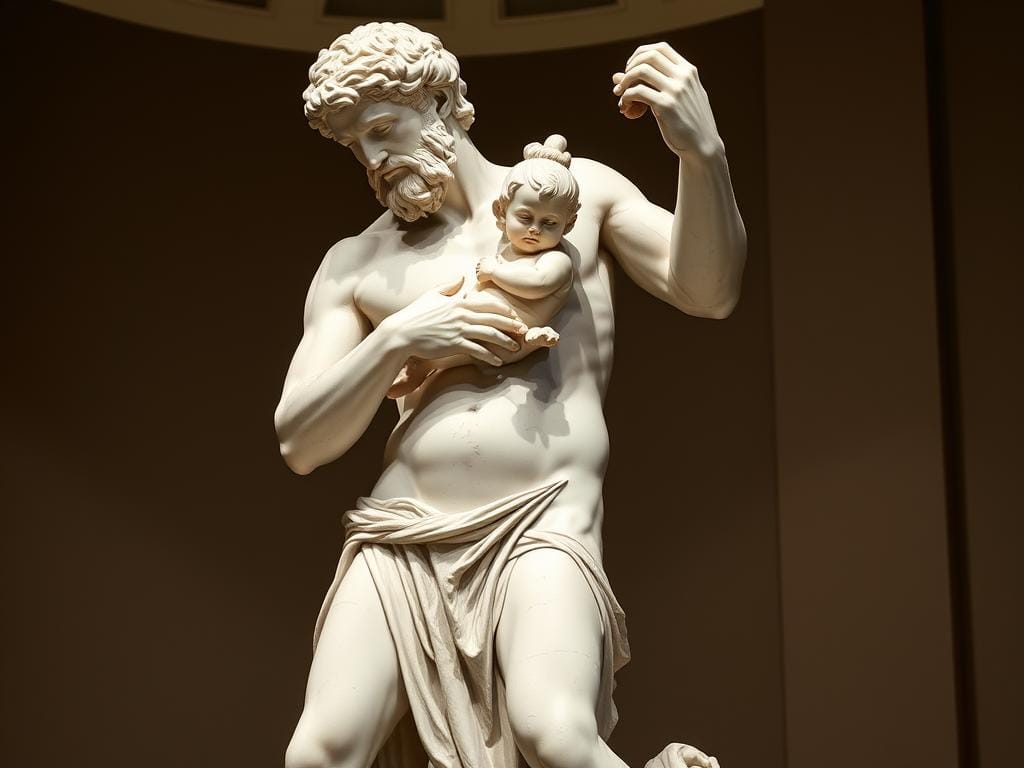
Hermes with the Infant Dionysus by Praxiteles – one of the most famous depictions of Hermes in classical art
The famous statue “Hermes with the Infant Dionysus” by Praxiteles exemplifies this Classical portrayal, showing a relaxed, graceful Hermes holding the baby Dionysus. This masterpiece captures the god’s protective nature alongside his physical perfection.
Worship of Hermes in Ancient Greece
The worship of Hermes Greek God was widespread throughout ancient Greece, though it often took different forms than the grand temple cults dedicated to gods like Apollo or Athena.
Sanctuaries and Rituals
While Hermes had temples in various Greek cities, his worship was more commonly practiced at wayside shrines and herms placed at crossroads, boundaries, and doorways. These simple stone markers served as focal points for travelers’ prayers and offerings.
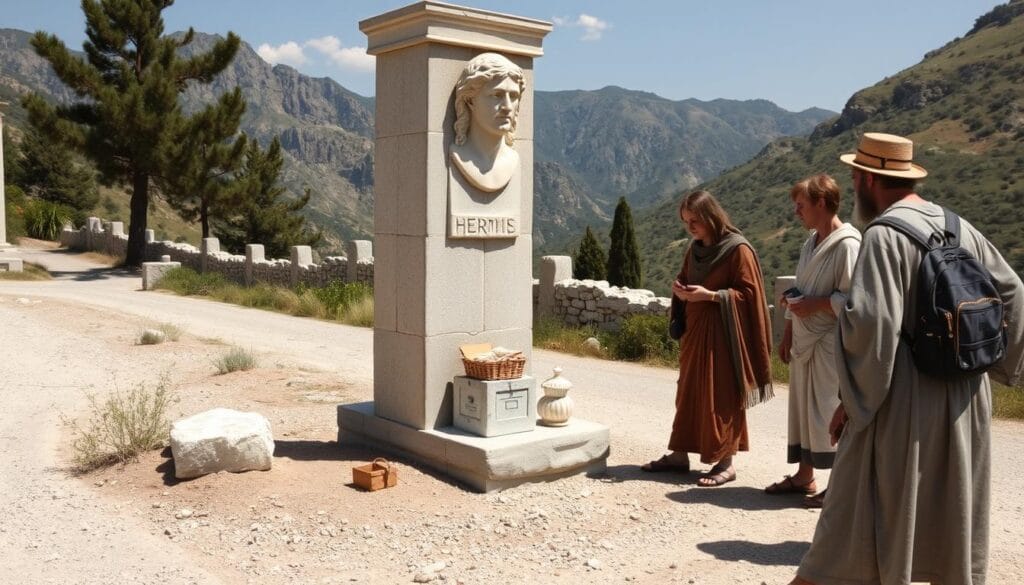
Offerings to Hermes typically included honey, cakes, incense, and occasionally the first fruits of harvest. Merchants might dedicate a portion of their profits to him, while travelers would add stones to cairns at crossroads as simple offerings for safe passage.
The festival of Hermaea celebrated Hermes in many Greek cities, particularly in gymnasiums where young men competed in athletic contests under his patronage. These festivals emphasized his connection to youth, athletics, and education.
Hermes and Hermeticism
In the Hellenistic period, Hermes became associated with wisdom and esoteric knowledge through his identification with the Egyptian god Thoth. This syncretism produced the figure of Hermes Trismegistus (“Thrice-Greatest Hermes”), supposedly an ancient sage who possessed divine knowledge.
The Hermetic texts attributed to this figure formed the basis of Hermeticism, a philosophical and religious tradition that influenced Western esotericism for centuries. These writings covered topics from alchemy and astrology to theology and magic, extending Hermes’ influence far beyond his original Greek context.
“As above, so below, as within, so without, as the universe, so the soul.”
The Emerald Tablet, attributed to Hermes Trismegistus
This transformation from Olympian messenger to cosmic teacher demonstrates how Hermes’ boundary-crossing nature allowed his worship to evolve and adapt across cultures and centuries.
Legacy of Hermes in Modern Culture
The influence of Hermes Greek God extends far beyond ancient Greece, permeating modern culture in ways both obvious and subtle.

Commercial and Brand Influence
Perhaps the most visible modern reference to Hermes is the luxury brand Hermès, which adopted both his name and aspects of his symbolism. The company’s logo evokes the god’s role as patron of travelers and merchants, connecting ancient divine protection to modern luxury goods.
The caduceus symbol appears frequently in commercial contexts, often mistakenly used as a symbol of medicine (confusing it with the Rod of Asclepius). It appears in logos for publishing companies, transportation services, and communication businesses – all industries that connect to Hermes’ original domains.
Literary and Artistic References
In literature, Hermes continues to appear as a character in retellings of Greek myths, such as Madeline Miller’s “Circe” and Rick Riordan’s “Percy Jackson” series. His trickster aspects have influenced characters across literary traditions, from Shakespeare’s Puck to modern comic book characters.
Artists continue to find inspiration in Hermes’ imagery. His dynamic, in-motion quality makes him a favorite subject for sculptors and painters seeking to capture movement and energy. Contemporary artists often use his boundary-crossing nature as a metaphor for communication across cultural divides.
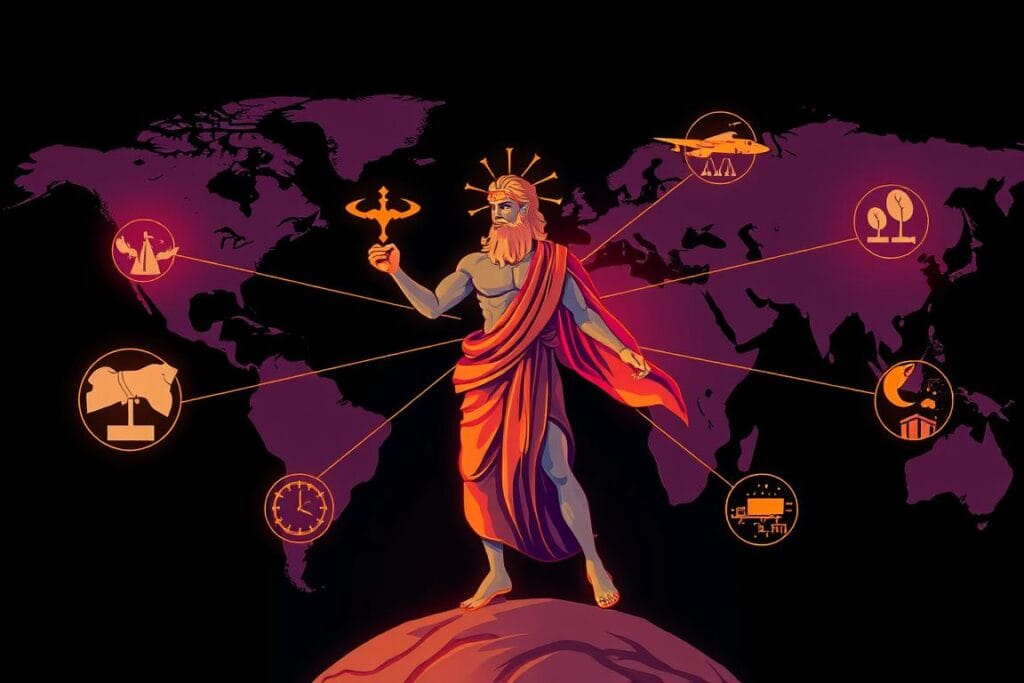
Psychological and Cultural Impact
In Jungian psychology, Hermes represents the archetype of the trickster and the guide – the part of consciousness that challenges established order while facilitating transformation. His ability to move between worlds makes him a symbol of psychological liminality and the unconscious mind.
The concept of “hermetic” knowledge – sealed, secret wisdom accessible only to initiates – derives from Hermes Trismegistus and continues to influence how we think about specialized knowledge and communication between different groups.
Conclusion: The Enduring Relevance of Hermes
Hermes Greek God stands as one of mythology’s most versatile and enduring figures. His dual nature as both messenger and trickster, guide and thief, reflects the complexity of human experience itself. In a world of rigid categories, Hermes represents the essential connections between seemingly opposite realms – divine and mortal, living and dead, sacred and profane.
His ability to cross boundaries with ease speaks to our own desire for mobility and connection across divides. As messenger, he reminds us of the power of communication; as psychopomp, he acknowledges the universal journey we all must take; as trickster, he challenges us to question established orders and find creative solutions to seemingly impossible problems.
Perhaps this is why Hermes continues to fascinate us – in his contradictions, we see our own multifaceted nature reflected. The swift-footed god still races through our cultural imagination, carrying messages across the boundaries of time itself.
Explore the World of Greek Mythology
Fascinated by Hermes and want to discover more about the rich pantheon of Greek gods? Download our free illustrated guide “The Olympians: Powers, Symbols & Stories” and continue your journey through ancient Greek mythology. This comprehensive resource includes detailed profiles of all major deities, their relationships, and the most significant myths that shaped ancient Greek culture.
